Report: Dangerous Goods May Have Caused Maersk Honam Fire

Singapore's Transport Safety Investigation Bureau has concluded its inquiry into the deadly fire aboard the boxship Maersk Honam in 2018. While the bureau was not able to conclusively determine the cause, its forensic investigators ruled out electrical faults, fuel tank heating, misdeclared goods and non-IMDG cargo ignition sources, leaving one possibility: a giant block stow of an oxidizing compound called sodium dichloroisocyanurate dihydrate (SDID).
SDID is a chlorinating agent classified as an IMDG Class 9 miscellaneous dangerous good - not a more dangerous Class 5.1 oxidizer. However, like a Class 5.1 chemical, it is highly oxidizing and has the potential for self-decomposition when stowed in bulk - much like the notorious self-heating compound calcium hypochlorite, which is used for identical end purposes.
When Maersk Honam set sail, a total of 1,000 tonnes of SDID was stowed in a cube-shaped stack of 54 containers in her number-three cargo hold, the location where the fire broke out. The stow was fully compliant, and Maersk's cargo-loading program detected no issues with the arrangement when it was placed on board.
At 1945 hours on March 6, 2018, while she was under way off the coast of Oman, a smoke alarm went off in her number three hold. The master headed for the bridge, and on the way up he smelled chlorine, though he saw no smoke. At 1951 hours, he instructed the chief mate to sound the fire alarm, and the crew mustered for a response. The two designated firefighting teams managed to shut off most of the vents around the hatch for the number three hold, but they could not seal off 16 natural ventilation flaps on the port side. Even though the vents were not fully closed, the master ordered the use of the CO2 flooding system in an attempt to extinguish the blaze.
At 2035 hours, with the smoke worsening, the master ordered all crew to muster on the bridge. He ordered two more rounds of CO2 flooding, including a full discharge on the final round. The last discharge was followed by several explosions and a large plume of smoke, which engulfed the accommodations block and led most of the crew to flee the bridge in panic.
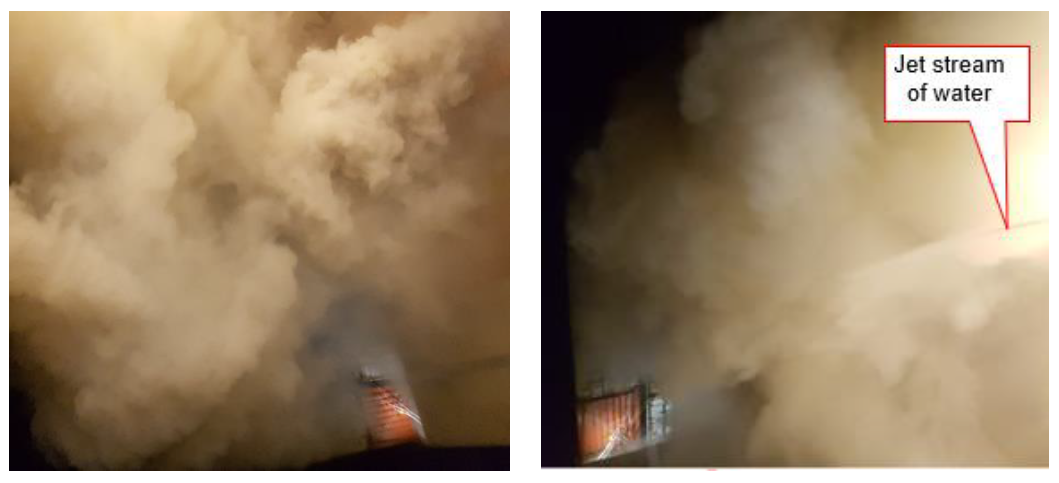
View from the port bridge wing during firefighting efforts (Maersk / Transport Safety Investigation Bureau)
The crew became separated into four groups, and each separately made its way aft to abandon ship. The 23 survivors were rescued by the boxship ALS Ceres; one of them - the ship's painter - died of his injuries before reaching shore.
During rescue and salvage operations, the bodies of two deceased crewmembers were found on the port side bridge wing, where they had been using fire hoses to assist with boundary cooling during the crew's firefighting effort. One more was found below the port side lifeboat. The final missing crewmember was not found.
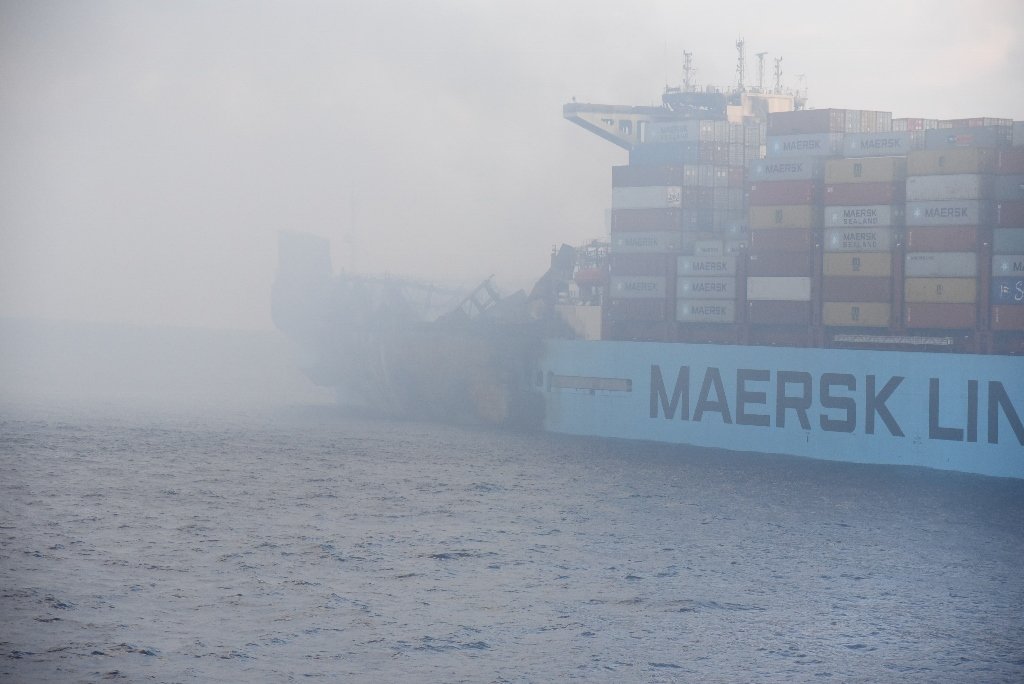
Image courtesy Indian Coast Guard
As for Maersk Honam, a multi-week salvage operation finally ended in late April 2018 when she was towed into Jebel Ali. After an extensive process of unloading the surviving cargo and evaluating the extensive damage in her forward holds, Maersk opted to scrap the ship's bow and deckhouse and ship the stern section to a South Korean yard for repair. The newly-remade vessel is currently trading as Maersk Halifax.
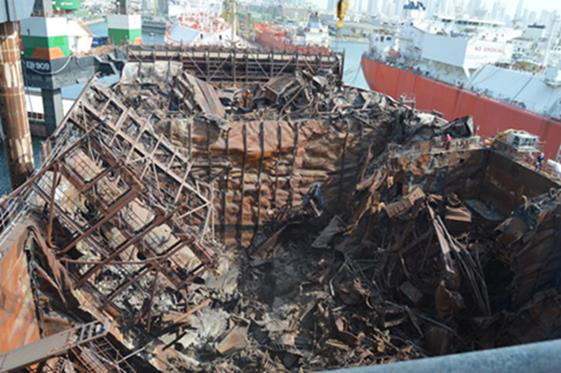
The remains of Maersk Honam's forward holds, 2018 (Transport Safety Investigation Bureau)
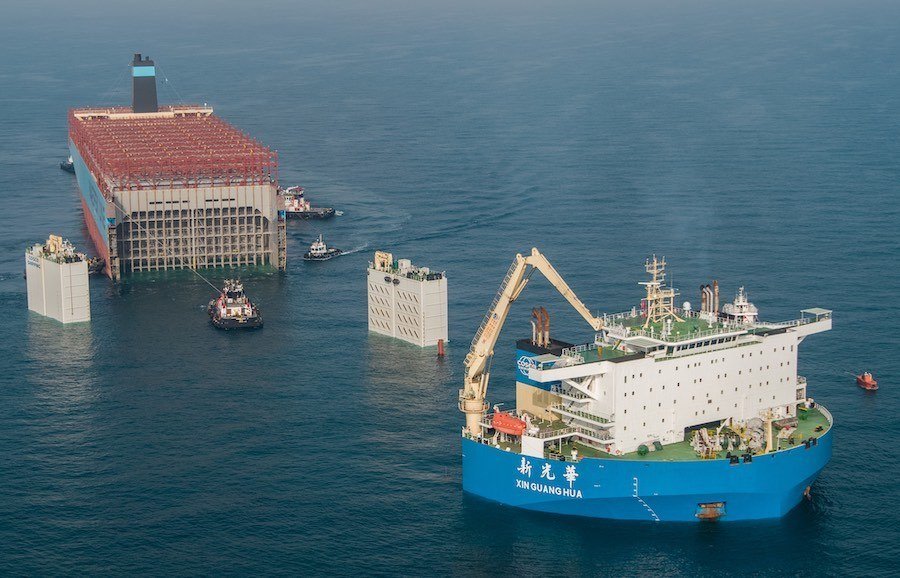
With bow and deckhouse removed, Maersk Honam's stern is loaded out for transport, 2018 (Maersk)
Evidence of a chemical source
The survivors told investigators that throughout the firefighting and abandon-ship evolutions, they encountered "white colored smoke with strong bleach/chemical smell," and they experienced breathing difficulty and skin irritation. A blue Maersk uniform recovered from the ship was bleached nearly white, and firefighting gear showed extensive bleaching discoloration.
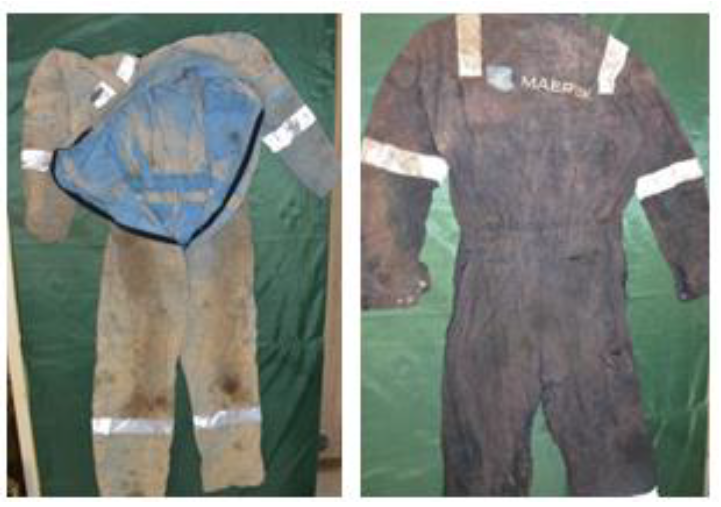
The formerly-blue boiler suit on the left was bleached nearly white (Transport Safety Investigation Bureau)
The investigators noted that this evidence would be consistent with exposure to the decomposition products of SDID. As the compound overheats and decomposes, it produces white smoke and chlorine gas. Its combustion results in the release of additional hazardous compounds, potentially including trichloramine, cyanogen chloride and phosgene.
Recommendations
Singapore's Transport Safety Investigation Bureau recommended several regulatory revisions to reduce the odds of a similar casualty, including:
- Requiring temperature sensors in cargo holds connected to the ship's fire detection system;
- Employing specially-designed cargo containers for IMDG goods, fitted with appropriate internal firefighting equipment that would self-activate in the event that the temperature in the container went too high;
- Reviewing the proper classification of SDID within the IMDG Code;
- Calling on carriers to treat SDID in the same way that they handle calcium hypochlorite - stowed on deck and away from sunlight;
- Reviewing SOLAS firefighting standards for boxships to address the risk of cargo hold fires.
In a statement, Maersk broadly agreed with the report's recommendations and noted that it has already implemented changes in its stowage requirements. Aboard Maersk ships, IMDG cargoes are no longer stowed next to accommodation and main propulsion plants; fire risk tolerance is now lower for belowdeck cargoes and higher for cargoes on deck fore and aft. Based on statistics on container fires in the Cargo Incident Notification System (CINS), Maersk has restricted which cargoes can be stored in each risk zone.
“We appreciate the thoroughness of the investigation in identifying opportunities to further improve our emergency response towards ship fires. We also appreciate TSIB’s recognition of the preventive measures taken by the A.P. Moller - Maersk and that TSIB is recognizing the need to review legislation linked with the safe transport of Dangerous Cargo. The main safety recommendations in the report we have already implemented across the fleet over the past two years and we will be studying the report further to understand how to best make use of the recommendations going forward,” said Aslak Ross, Maersk's head of marine services.
Broader issues with chemical classification and firefighting

that matters most
Get the latest maritime news delivered to your inbox daily.
Nick Haslam, a master mariner and salvor with consultancy Brookes Bell, was appointed by the owners’ P&I Club to assist on the salvage service for the Maersk Honam response. In a recent interview, he suggested that the casualty illustrates a fundamental problem with IMDG certification: as long as chemical manufacturers are allowed to self-certify their products’ characteristics, dangerous compounds will end up in the wrong place on board. "The IMDG Code relies on the manufacturer's self-certification, but it's almost impossible to police," Haslam said in a recent interview. "What we need is accurate testing, and not just 50 gram samples in a laboratory setting."
He also doesn't see much to be gained from having the crew combat a giant hold fire like the inferno on Maersk Honam, and points to the fact that some of the victims were engaged in firefighting. "You know, you've got a team of three men who have done one or two firefighting courses in their life, and they're standing there with a two-and-a-half inch firehose spraying water into a volcano," Haslam said. "As far as I'm concerned, you set off the CO2, assess the fire, and then ready lifeboats and evacuate the vessel."
